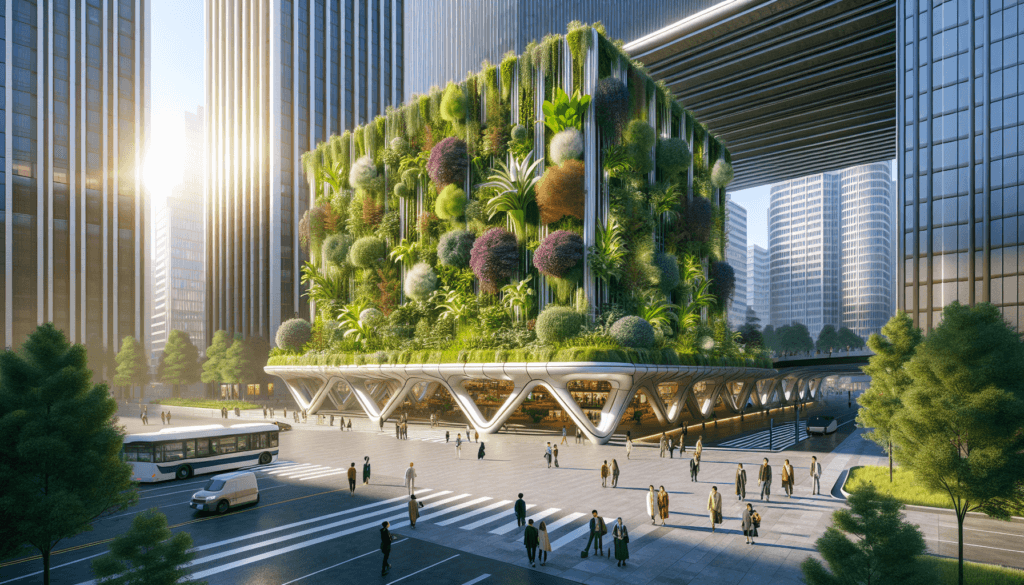Imagine living in a concrete jungle where skyscrapers tower over you and the only glimpse of nature is through a small park. Now envision a world where vibrant green walls and vertical gardens surround you, softening the harshness of urban life. These green oases not only enhance the aesthetics of the city but also bring numerous benefits to urban environments. From improving air quality to providing insulation, the benefits of green walls and vertical gardens are truly remarkable. Discover how these innovative solutions are transforming our cities into healthier and more sustainable havens.

Improved Air Quality
Green walls and vertical gardens have a significant impact on improving air quality in urban environments. By covering surfaces with plants, these innovative structures effectively reduce air pollution. They act as natural air purification systems, removing toxins and pollutants from the surrounding atmosphere. The plants within the walls absorb pollutants such as carbon dioxide, nitrogen dioxide, and particulate matter, helping to create cleaner and fresher air. Additionally, green walls and vertical gardens increase oxygen production, releasing a steady stream of fresh oxygen into the surrounding environment.
Enhanced Aesthetics
The introduction of green walls and vertical gardens in urban environments creates visually appealing spaces that enhance the overall aesthetics of the area. These structures seamlessly integrate with architectural designs, transforming bland walls into stunning displays of vibrant greenery. The vertical gardens can be designed in various patterns and arrangements, creating opportunities for art and creativity. This infusion of natural elements adds a touch of beauty and liveliness to the urban landscape, making it more inviting and enjoyable for residents and visitors alike.

Enhanced Biodiversity
Green walls and vertical gardens play a crucial role in supporting and promoting biodiversity in urban settings. The diverse array of plants used in these structures provides a habitat for various species, including insects, birds, and butterflies. The vertical gardens create a microenvironment that fosters plant and insect diversity, helping to maintain the delicate balance of urban ecosystems. By incorporating green walls and vertical gardens, urban areas can actively contribute to the preservation of biodiversity and create a welcoming environment for a wide range of species.
Improved Mental Health
The presence of green walls and vertical gardens in urban environments has been proven to have a positive impact on mental health. Spending time surrounded by nature and greenery has a soothing and calming effect on individuals, reducing stress and promoting relaxation. The lush greenery of these structures helps create a sense of well-being and happiness, providing a peaceful oasis in the midst of the bustling city. Additionally, research has shown that exposure to nature improves cognitive function, particularly attention and memory, further enhancing mental well-being.

Noise Reduction
One of the often-overlooked benefits of green walls and vertical gardens is their ability to absorb sound waves and reduce noise pollution. The plants in these structures act as natural sound absorbers, helping to mitigate the negative effects of urban noise. They effectively block traffic noise and other disruptive sounds, creating quieter environments that promote tranquility and improve overall quality of life. By incorporating green walls and vertical gardens in urban areas, city dwellers can enjoy the peace and serenity that comes with reduced noise levels.
Temperature Regulation
Green walls and vertical gardens contribute to the regulation of temperatures in urban environments, addressing the issue of the urban heat island effect. The dense vegetation and plant-filled structures help moderate temperatures by providing shade and absorbing solar radiation. This mitigates the excessive heat often experienced in heavily built-up areas. Furthermore, green walls and vertical gardens act as natural insulation for buildings, reducing the need for excessive air conditioning or heating. The result is a decrease in energy consumption, leading to a more sustainable and eco-friendly urban environment.

Water Management
The inclusion of green walls and vertical gardens in urban landscapes offers numerous benefits in terms of water management. These structures help reduce stormwater runoff by absorbing and storing rainfall, preventing excess water from overwhelming drainage systems. In addition, the plants within green walls and vertical gardens act as natural filters, purifying water and reducing the amount of pollution entering local waterways. Through these mechanisms, these structures minimize water pollution and contribute to the conservation and management of water resources in urban areas.
Improved Food Production
Green walls and vertical gardens create new opportunities for urban farming, revolutionizing access to fresh produce in densely populated areas. By utilizing these innovative structures, urban dwellers can grow their own food in limited spaces, fostering a sense of self-sufficiency and promoting sustainable food systems. The availability of fresh and locally sourced produce not only improves the quality of diets but also reduces the carbon footprint associated with long-distance food transportation. Green walls and vertical gardens are indeed a green revolution in urban food production.

Health Benefits
The integration of green walls and vertical gardens in urban environments has profound health benefits, particularly in reducing the occurrence of respiratory diseases. The plants within these structures act as natural air filters, removing pollutants and improving air quality, thereby reducing the risk of respiratory illnesses. Additionally, spending time in the presence of nature and greenery has been linked to reduced stress-related illnesses, such as anxiety and depression. Moreover, exposure to nature strengthens the immune system, enhancing overall health and well-being.
Social and Community Engagement
Green walls and vertical gardens create communal spaces that bring people together and strengthen community bonds. These structures provide opportunities for various activities, such as gardening and interacting with nature, fostering a sense of community and shared responsibility. Urban dwellers can come together to care for and maintain these green spaces, promoting a sense of ownership and pride in their neighborhoods. The presence of green walls and vertical gardens encourages social interaction, creating opportunities for residents to connect with one another and form lasting relationships.
In conclusion, the benefits of green walls and vertical gardens in urban environments are far-reaching. They improve air quality, enhance aesthetics, promote biodiversity, and contribute to mental health and well-being. Additionally, these innovative structures reduce noise pollution, regulate temperatures, manage water effectively, enhance food production, and offer various health benefits. Furthermore, green walls and vertical gardens foster social and community engagement, strengthening bonds among urban residents. Embracing the concept of green walls and vertical gardens undoubtedly enhances the quality of urban life, creating sustainable and livable cities for current and future generations.


